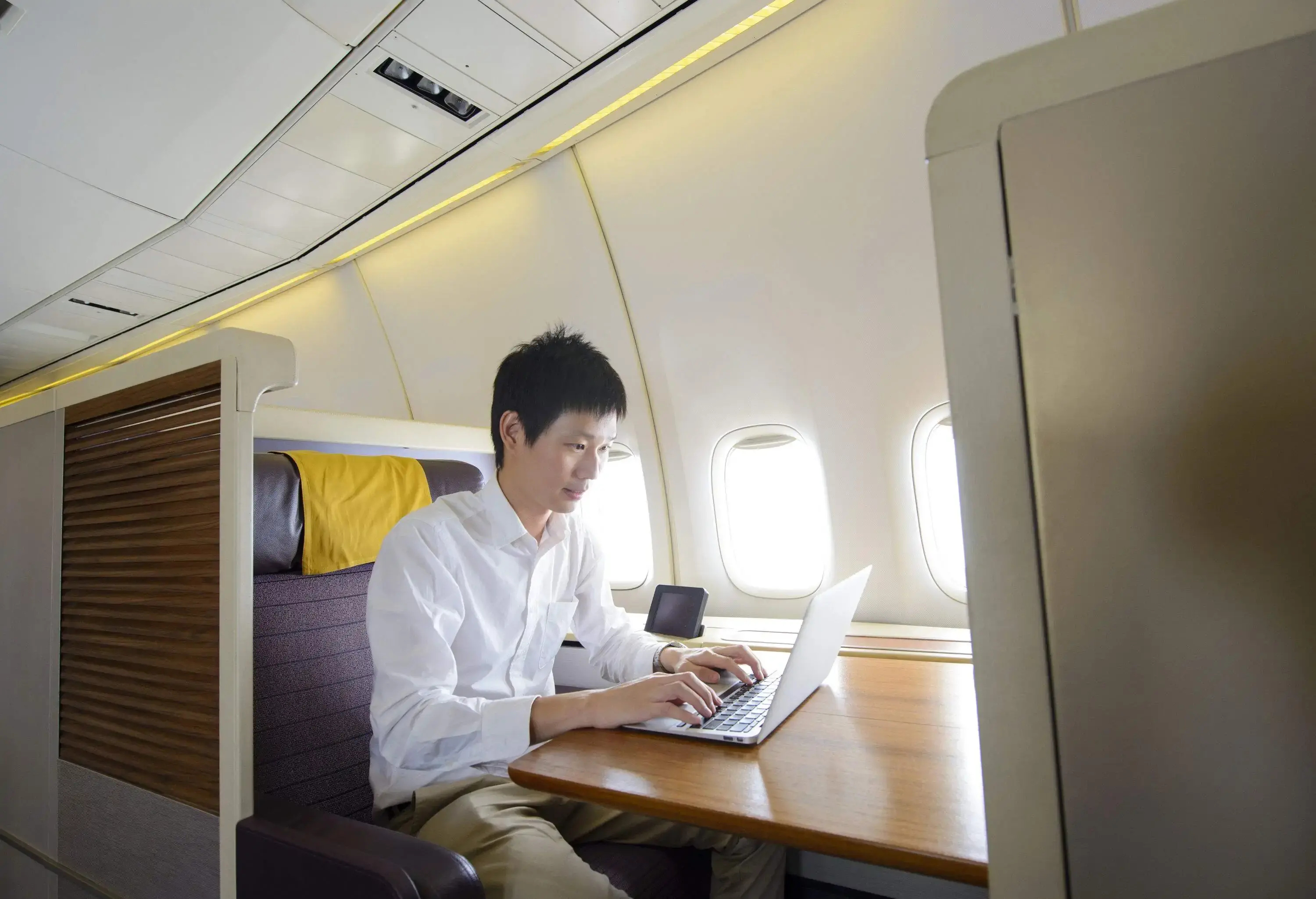Essential steps to take before the airport
Plane tickets purchased? Check. Hotel room booked? Check. Rental car reserved? Check. While completing the travel trifecta of plane-hotel-car bookings may signal the end of vacation planning to some travelers, it’s actually just the beginning of a litany of tasks to check off before your flight. It’s enough to overshadow the excitement of air travel, but, with our help, it doesn’t have to.
More than 3.3 billion people flew the friendly skies in 2014, according to the International Civil Aviation Organization, a United Nations agency that manages the administration and governance of the Convention on International Civil Aviation. With increased security measures and a 5.5 percent increase in airline passengers this year, breezing through the airport takes a bit more effort than simply swiping a credit card, checking your bags and saying “Bon Voyage.”
Stick to this list of 10 tasks and air travel tips for first-time flyers and globetrotters alike, and you will be ready and on your way in no time.
How to prepare for your next flight
1. Research your trip
2. Make plans
3. Have passport, IDs and visas ready
4. Obtain travel insurance
5. Get immunizations
6. Fill prescriptions
7. Prep your home
8. Secure your finances
9. Pack smart
10. Prep for airport security
1. Research, research, research your trip
Before you head to an unknown destination, do a little research and bring along a guidebook and/or map and download travel apps to familiarize yourself with your destination. Be sure to prepare for the following situations:
- Read up on how to avoid hidden fees that can bust your travel budget.
- If you’re flying on a low-cost air carrier, read up on what to expect.
- How do you get from the airport to your accommodation? Most public transportation maps are also available online; it’s a good idea to print out a map of the area before you leave. Consider printing out specific sections from travel guides online to read on the plane and refer to during your trip.
- What is the local currency and what is the exchange rate? Sites like Oanda.com and xe.com are great resources.
- What is the weather like this time of year? The day before you leave, check the weather conditions and make any necessary adjustments to clothes and amenities.
- What are the emergency phone numbers for your destination?
- Do you know what to do in the event the subway system is not working or you get lost on public transportation? What happens if your commuter train is delayed? If you missed the bus at one bus stop, how do you get to the next stop? Map out your journey in advance using travel apps, your hotel concierge or a guidebook/map.
- Do you know some basic phrases in the local language?
- Read our guide to traveling with dietary restrictions and food allergies for advice on traveling with food allergies and dietary restrictions and our tips for vegetarians and vegans on vacay to keep your diet on track.
- Headed to an all-inclusive resort, check out our insider’s guide to all-inclusive resorts.
- Planning a long drive after you land at your destination? Read our tips for a worry-free road trip.
- Staying in a home rental? Read our beginner’s guide to home rentals.
- Staying at a hostel? Consult our first-timer’s guide to staying in a hostel.
- Strapping on a backpack and hitting the open road? Consult our tips for your first backpacking adventure.
- Breastfeeding mom? Here are some helpful hints and packing tips for breastfeeding moms.
- Consider how you will stay in touch while you are away. Will you need an international roaming plan, or will you rely on Wi-Fi to stay connected. Check out our tips for avoiding high smartphone costs while abroad.
2. Make plans
Whether you’re planning a spa vacation, golf getaway or just a romantic dinner for two at your destination’s top restaurant, it’s a good idea to make plans and reservations before the trip.
- Consult guidebooks, websites and travel apps to learn about the destination.
- Check out the local entertainment guides, city newspapers and online entertainment sites to find the best restaurants and hottest shows.
- The hotel concierge is a good source for recommendations if you’re unsure of where to book. Call the hotel before your trip and ask the concierge to send you a list of restaurants, golf courses, spas or other entertainment activities in the area.
- Have a layover? Consult our kids airport diversion guide for advice on entertaining your little ones.
3. Have passports, IDs & visas ready
For domestic air travel, all adult passengers must present some form of government-issued photo identification. A valid driver’s license or passport will work. Heading to Europe? For international air travel, all passengers (including children) must have a valid passport. Be sure your driver’s license or state ID has not expired.
In general, if you want to travel outside the U.S., you will need a passport to prove your identity, enter other countries and re-enter the U.S. A passport is an officially issued government document certifying your identity and citizenship, allowing you to travel abroad with the protections guaranteed to U.S. citizens. Here is our guide for how to apply for a passport. Apply early for a passport and check out our passport photo tips.
If you already have a passport, be sure it is valid for six months or more as some countries will not allow you to enter with a passport with an expiry date within six months. Some countries also require that your passport contain one or more blank pages for stamps.
If you are traveling abroad, confirm whether you need a visa to enter. Contact the embassy of the country you are visiting and the U.S. Department of State. If you do need a visa, submit your visa application early, as it can take weeks to process depending on your destination. Visit the U.S. Department of State website for comprehensive information regarding passports, visas and other documents required for travel no matter where you’re headed.
4. Obtain travel insurance
You might already have some insurance coverage and just don’t know about it. Check with your health insurance provider, credit card company or auto club and see what’s covered during travel. Some travel insurance plans include overseas medical coverage; some just cover personal property and transportation expenses. Be sure to check with your current medical insurance provider to see what’s covered out of state and overseas. Travelers can also buy supplementary travel insurance that provides benefits like emergency medical evacuation and repatriation of remains.
5. Get immunizations
For some regions of the world, immunizations are necessary prior to travel. Proof of immunization is a requirement for entering some countries. It’s best to schedule a visit to your doctor to discuss your travel plans and medical conditions. Some immunizations require more than one shot and some prescriptions like anti-malarial medications may have to be started weeks in advance. Consult the Centers for Disease Control and Prevention, which includes destination-specific information.
6. Fill prescriptions
Nothing will put the brakes on a trip like getting sick or injured. Despite travelers’ best efforts to prepare and prevent common ailments while on-the-go, it’s inevitable that at some point you may need to troubleshoot health issues while traveling. Be sure to fill all prescriptions, stock up on common over-the-counter medications and read up on how to troubleshoot health issues while traveling, which includes advice on what to pack before your trip to be prepared for the most common health issues while traveling, from jet lag, blisters and jellyfish stings to sunburn, traveler’s diarrhea and altitude sickness. Check out these tips from a pro for staying healthy while traveling.
While most travelers might not think twice about tossing aspirin and routine prescription medications into their bags, traveling with medication should take some thought and pre-planning. Unbeknownst to you, your prescription medicines and even some over-the-counter medications might be illegal where you are headed. From how to pack your medication to what to do if you run out of medication while abroad, read our tips for traveling with medication.
If you have allergies to certain medications, foods, insect bites, or other unique medical problems, consider wearing a “medical alert” bracelet and carrying a letter from your doctor explaining required treatment if you become ill.
7. Prep your home
Depending on the length of your trip, there are several things you should do around the house.
- Place a “stop” or “hold” on mail and deliveries.
Daily newspapers, magazines and mail will pile up while you’re on vacation. Don’t become a target for burglary. Place a temporary stop on all deliveries. Call the newspaper circulation department and let them know you will be placing your delivery on hold for the time you’re away. Place a hold your mail for the time you’re traveling by calling or visiting your nearest post office branch. - Set up pet care.
If you have furry friends at home that can’t travel with you, make sure they are well provided for before you leave town. This includes making reservations with local pet sitters, “doggie day care,” kennels or your vet. If it’s your pet’s first time with a pet sitting service, it’s a great idea to set up a meeting in advance with the pet sitter to introduce your pet. If your pet is going to stay outside your home, consider dropping your pet off for a few hours at the “doggie day care” or kennel as a trial before dropping your pet off for a longer stay. If you are considering taking your furry friend along, check out our tips for flying with pets. - The following is a pet care checklist:
- Ensure your pet’s vaccinations are up-to-date.
- Leave emergency phone numbers, your vet contact info, and your itinerary and contact info while on vacation with the pet sitter.
- Make sure all medications for your pet and the veterinarian’s phone number are packed with your pet before you leave.
- Provide the pet sitter with a written summary of your pet’s daily schedule and habits as well as any special instructions.
- If your pet is staying outside your home, be sure to pack ample food (pack more than estimated in case your travels are delayed), medicine, treats and favorite toys. You may want to include a piece of your clothing so your pet can feel comforted in your absence with a reminder of you.
- Confirm your reservation prior to the trip.
- Get a house sitter.
Ask a family member or neighbor to check on your home while you’re away and be on the lookout for any suspicious activity in your absence. Be sure to gift them a souvenir in exchange for watering your plants, keeping an eye on your home and picking up your mail and newspaper. (If you are only away on a short trip or have to travel last minute, it might not be practical to stop or hold all deliveries). - Make copies.
Ever lose your passport or wallet while traveling? It’s not pretty. Avoid as much hassle as possible by making copies of all important documents, including a copy of the contents of your wallet, passport, visas, immunization card and prescriptions, before you go and store them in a safe place on your journey.- Do not keep the photocopies with your actual passport. Leave the copies in a safe in the hotel room or in your locked luggage.
- Leave photocopies at home with somebody you can get in touch with in an emergency.
- Leave emergency contact information and copies of your passport biographic data page and prescriptions with family and trusted friends.
- Take two copies with you, one in your carry on and one in your checked luggage.
- Carry emergency contact information for your family with you when you travel. Be sure to also pencil this information in the emergency contact information section of your passport too.
- Learn the contact information for the nearest U.S. embassy or consulate, available on the State Department’s Country Specific Information page for each country and on each embassy or consulate’s website. Provide this information to your family and friends in case of an emergency.
- Make lists (and check them twice).
Prior to your trip, prepare the following:- A packing list to ensure you don’t forget any essentials.
- A list of emergency and essential travel numbers to take with you. Be sure to leave a copy with your family too. Those contacts include: Credit card companies, your doctor’s office, the U.S. embassy in the country you’re visiting; and airline/hotel/car rental phone numbers.
- Arrange travel to the airport
Book a car service or map your route via public transportation prior to landing in your destination.
8. Secure your finances
Don’t leave home without several money options, including credit and/or debit cards, an ATM card and cash. While some traveler’s prefer to carry traveler’s checks and get a small amount of local currency ahead of time, travelers will get the best exchange rate via an ATM machine in the country. If you want to take traveler’s checks, be sure to write down the check numbers and keep them in a safe place should your checks be lost or stolen. (Leave a copy of the numbers with a family member or friend at home too.)
Never leave town without some cash. If you’re traveling within the country, make sure to hit the bank before you leave. Taking cash with you will ensure you don’t pay ATM surcharge fees in another destination.
Look up the exchange rate prior to your trip. Read up on local customs and tipping etiquette.
If you’re traveling abroad, it’s best to bring some U.S. currency in small bills for use in case you need to exchange additional money. Some countries, like many Caribbean countries and Canada, accept U.S. currency too. If your trip is short, you might not need to obtain local currency.
Before your trip, call your credit card company and bank and inform them of your travel plans. Many credit cards offer identity protection plans to help protect cardholders from theft and fraud. During your call to the credit card company, ensures you are able to verify your credit card, debit card and ATM cards will work at your destination. You can also verify any associated fees for charges, withdrawals and cash advances as well as currency conversion fees. It’s ideal to carry more than one credit card, as merchants don’t always accept all of the four major cards. Check the back of your credit card for more customer service numbers or call:
- MasterCard: 1-800-627-8372
- VISA: 1-800-847-2911
- Discover: 1-800-347-2683
- American Express: 1-800-528-4800
When it comes to packing, keep your funds in several different places.
- With travelers’ checks, keep your receipts separate from your checks.
- Carry enough local currency to pay for a taxi from the airport, meals, and the first hotel night (if you haven’t already paid).
- Find a secure way to carry your funds and travel documents.
- Money belts are terrific for holding the bulk of your cash.
9. Pack smart
Check your airline’s baggage allowance to confirm the size, weight and number of carry-on bags you are allowed. If you have to check bags, confirm the size, weight and cost, as most airlines now charge for checked baggage (some even charge for carry-on bags). Don’t lock your checked luggage – security will open them.
No matter your packing habits or style, follow these tips for traveling light and smart:
- Pack everything in your carry-on that you would need to survive if you lost your luggage, including your passport, ID, wallet, all tickets, travel documents, medications (prescription and over the counter), cellphone and laptop. Consider also packing a change of clothes, gadget charger and/or converter and a snack.
- Don’t over pack your carry-on. Check out the amenities your airline offers for free and learn the dos and don’ts of bringing alcohol on a flight.
- It is possible to travel with just one carry-on. Check out our tips to travel with one carry-on.
- Checking bags? You can still travel light. First, pack your bags. Then, take everything out, leave half of the contents on your bedroom floor, and pack again.
- Pack the night before to avoid packing in a rush. Double check before leaving the house that you have all necessary essentials to travel with. Do you know where your passport or driver’s license is located? Did you pack all your necessary medications? The best way to ensure you’ve packed everything necessary for your trip is to make a list of your daily needs for one week. List everything from your medications to the credit cards you use. When it comes time for packing, refer to your list so you don’t forget anything important.
- Charge all your gadgets, from your laptop to your cellphone. If you forget or don’t have time to charge everything, consult our guide to U.S. airport charging stations and our airline seat guide, which gives information of how to determine if your seat has charging points.
- Confirm your seat and print your ticket. Most airlines allow you to check in starting 24 hours prior to your departure (up to 72 hours for international flights). If you haven’t selected your seat, now is the time to do it. (Check out our tips for booking the best airline seat.) Check-in online and print your tickets or download the airline’s app to access your boarding pass. Doing this in advance means one less line to wait in at the airport. Just drop off your bags (if you’re checking them) and head straight to security.
10. Prep for airport security
You know the drill. Hurry up to get to the airport two hours or more before takeoff only to wait in long, winding security lines at the airport. Fortunately, there are several travel programs that can help you breeze through security and customs lines.
TSA Pre✓ and CLEAR are two programs that help propel passengers to the front of and through security lines. U.S. Customs and Border Patrol runs four Trusted Traveler Programs: Global Entry (for international travel), NEXUS (for travel between the U.S. and Canada), SENTRI (Secure Electric Network for Travelers Rapid Inspection: for travel via land into the U.S. from Mexico) and FAST (Free and Secure Trade: for commercial vehicles traveling between U.S and Mexico and U.S. and Canada) to help travelers breeze through borders.
Globetrotters can simultaneously enroll in the quartet of Trusted Traveler Programs, TSA Pre✓ and CLEAR as each program offers specific benefits based on where you are headed. We break down the who, what, where, when, why and how of the four most popular programs: CLEAR, TSA Pre✓, Global Entry and NEXUS.
Main image: iStockPhoto.com/LeoPatrizi




